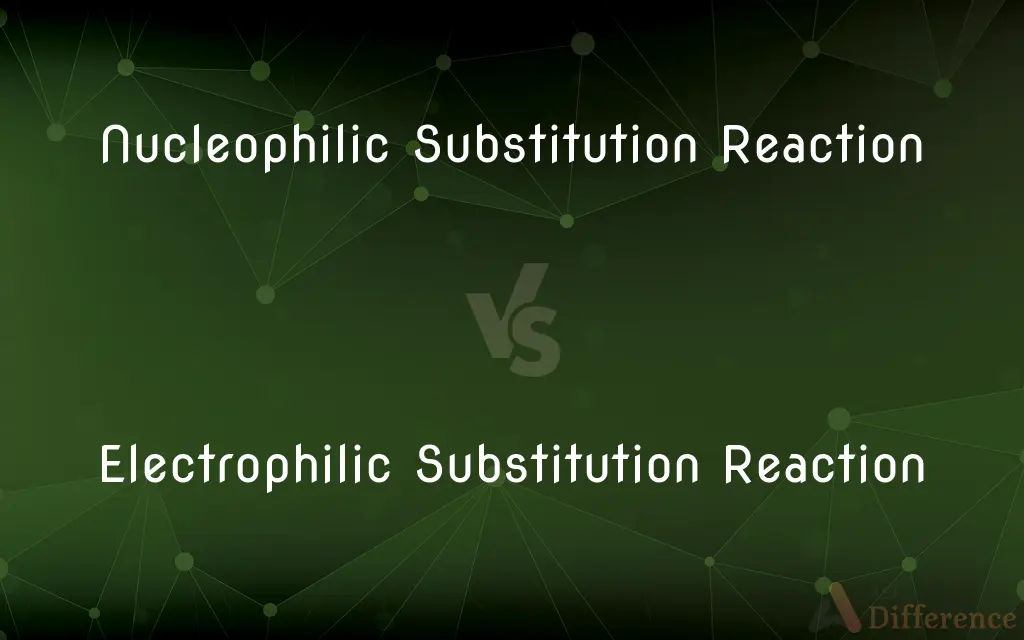Nucleophilic Substitution Reaction vs. Electrophilic Substitution Reaction — What's the Difference?
By Tayyaba Rehman — Published on December 27, 2023
Nucleophilic Substitution Reaction involves a nucleophile replacing another group in a molecule; Electrophilic Substitution Reaction involves an electrophile replacing another group.

Difference Between Nucleophilic Substitution Reaction and Electrophilic Substitution Reaction
Table of Contents
ADVERTISEMENT
Key Differences
Nucleophilic Substitution Reaction and Electrophilic Substitution Reaction are both organic chemical reactions that involve the replacement of an atom or a group in a molecule. However, the main difference lies in the type of reactive species involved in the substitution.
In a Nucleophilic Substitution Reaction, a nucleophile, which is an electron-rich species, approaches a molecule and replaces another group or atom. The group being replaced is typically a leaving group that departs with a pair of electrons. Electrophilic Substitution Reaction, on the other hand, involves an electrophile, an electron-deficient species, that replaces a part of the molecule.
Nucleophilic Substitution Reaction often occurs in molecules that have polarized bonds, where a partial positive charge attracts the nucleophile. Electrophilic Substitution Reaction, in contrast, usually happens with molecules that have areas of high electron density, making them targets for the electrophiles.
Examples of Nucleophilic Substitution Reaction include the reaction of an alkyl halide with a hydroxide ion. Electrophilic Substitution Reaction is frequently seen in aromatic compounds, where an electrophile replaces a hydrogen atom on the aromatic ring.
The rate, mechanism, and conditions under which Nucleophilic Substitution Reaction and Electrophilic Substitution Reaction occur can differ greatly, dictated by the nature of the nucleophile and electrophile, respectively.
ADVERTISEMENT
Comparison Chart
Reactive Species
Nucleophile (electron-rich)
Electrophile (electron-deficient)
Typical Targets
Molecules with polarized bonds
Molecules with high electron density
Common Occurrence
Alkyl halides, alcohols
Aromatic compounds
Reaction Mechanism
SN1 or SN2
SE mechanism
Dependency
Dependent on strength & sterics of nucleophile
Dependent on strength & electrophilicity of electrophile
Compare with Definitions
Nucleophilic Substitution Reaction
A chemical process where a molecule's part is exchanged for a nucleophile.
A Nucleophilic Substitution Reaction between bromoethane and ammonia produces ethylamine.
Electrophilic Substitution Reaction
A reaction where an electron-deficient species (electrophile) replaces a part of a molecule.
Benzene reacts with chlorine in the presence of a catalyst in an Electrophilic Substitution Reaction to form chlorobenzene.
Nucleophilic Substitution Reaction
An organic reaction involving the replacement of a molecule's leaving group by a nucleophile.
In the synthesis of ethers, alcohols can participate in a Nucleophilic Substitution Reaction.
Electrophilic Substitution Reaction
A chemical process where a molecule's part is exchanged for an electrophile.
The nitration of benzene involves an Electrophilic Substitution Reaction with nitronium ions.
Nucleophilic Substitution Reaction
A reaction where an electron-rich species (nucleophile) replaces another group in a molecule.
In the presence of hydroxide, an alkyl halide can undergo a Nucleophilic Substitution Reaction to form an alcohol.
Electrophilic Substitution Reaction
A molecular transformation where an electrophile seeks areas of high electron density in a molecule for substitution.
The sulfonation of benzene is an Electrophilic Substitution Reaction using sulfur trioxide.
Nucleophilic Substitution Reaction
A molecular transformation dictated by the attraction of a nucleophile to a positive or partially positive center.
The formation of an alkyl sulfonate from an alcohol is an example of a Nucleophilic Substitution Reaction.
Electrophilic Substitution Reaction
A mechanism-based reaction in which an electron-deficient agent targets an electron-rich area in a molecule.
In the presence of FeBr₃, benzene undergoes an Electrophilic Substitution Reaction with bromine.
Nucleophilic Substitution Reaction
A mechanism-based reaction in which an electron-rich agent targets a positively polarized atom in a molecule.
The reaction between sodium cyanide and an alkyl halide showcases a Nucleophilic Substitution Reaction.
Electrophilic Substitution Reaction
An organic reaction involving the replacement of a hydrogen atom or another group by an electrophile.
The bromination of aniline takes place via an Electrophilic Substitution Reaction.
Common Curiosities
Why is benzene often associated with Electrophilic Substitution Reactions?
Due to its high electron density and resonance-stabilized structure.
Can both reactions occur in the same molecule?
Yes, but under different conditions and mechanisms.
Why do Electrophilic Substitution Reactions commonly occur on aromatic rings?
Aromatic rings have areas of high electron density which attract electrophiles.
In which type of molecules do Nucleophilic Substitution Reactions commonly occur?
Typically in molecules with polarized bonds, like alkyl halides.
Are all nucleophiles strong bases in the context of a Nucleophilic Substitution Reaction?
Not necessarily. A molecule can be a good nucleophile but a weak base.
What's the primary species involved in a Nucleophilic Substitution Reaction?
An electron-rich species called a nucleophile.
What's a leaving group in the context of a Nucleophilic Substitution Reaction?
The atom or group that gets replaced by a nucleophile.
How does an Electrophilic Substitution Reaction differ from its nucleophilic counterpart?
It involves an electron-deficient species, an electrophile, replacing a part of a molecule.
What dictates the mechanism of an Electrophilic Substitution Reaction?
The nature and strength of the electrophile and the substrate.
Which reaction is more prevalent in alkyl halides: Nucleophilic Substitution or Electrophilic Substitution?
Nucleophilic Substitution Reaction is more common in alkyl halides.
What's a common reagent for Electrophilic Substitution Reaction in benzene?
Halogens in the presence of a halogen carrier, like FeCl₃ or FeBr₃.
Share Your Discovery

Previous Comparison
Maglev Train vs. Bullet Train
Next Comparison
Ruffles vs. FrillsAuthor Spotlight
Written by
Tayyaba RehmanTayyaba Rehman is a distinguished writer, currently serving as a primary contributor to askdifference.com. As a researcher in semantics and etymology, Tayyaba's passion for the complexity of languages and their distinctions has found a perfect home on the platform. Tayyaba delves into the intricacies of language, distinguishing between commonly confused words and phrases, thereby providing clarity for readers worldwide.
















































